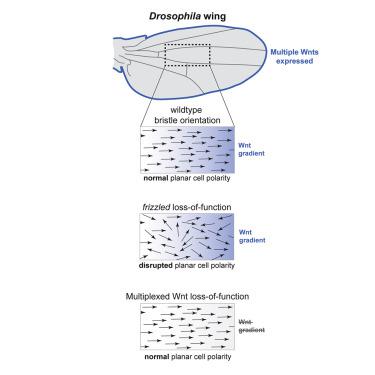Cell Reports ( IF 7.5 ) Pub Date : 2020-09-08 , DOI: 10.1016/j.celrep.2020.108121 Ben Ewen-Campen 1 , Typhaine Comyn 1 , Eric Vogt 1 , Norbert Perrimon 2

|
The frizzled (fz) and dishevelled (dsh) genes are highly conserved members of both the planar cell polarity (PCP) pathway and the Wnt signaling pathway. Given these dual functions, several studies have examined whether Wnt ligands provide a tissue-scale orientation cue for PCP establishment during development, and these studies have reached differing conclusions. Here, we re-examine this issue in the Drosophila melanogaster wing and notum using split-Gal4 co-expression analysis, multiplex somatic CRISPR, and double RNAi experiments. Pairwise loss-of-function experiments targeting wg together with other Wnt genes, via somatic CRISPR or RNAi, do not produce PCP defects in the wing or notum. In addition, somatic CRISPR against evi (aka wntless), which is required for the secretion of Wnt ligands, did not produce detectable PCP phenotypes. Altogether, our results do not support the hypothesis that Wnt ligands contribute to PCP signaling in the Drosophila wing or notum.
中文翻译:

没有证据表明果蝇的平面细胞极性需要Wnt配体。
的卷曲(FZ)和散乱(DSH)基因是高度保守的平面细胞极性(PCP)途径和Wnt信号传导途径两者的成员。鉴于这些双重功能,数项研究检查了Wnt配体是否在发育过程中为PCP的建立提供了组织规模的定向线索,并且这些研究得出了不同的结论。在这里,我们使用split-Gal4共表达分析,多重体细胞CRISPR和双RNAi实验在果蝇果蝇翼和notum中重新检查此问题。针对wg的成对功能丧失实验通过体细胞CRISPR或RNAi与其他Wnt基因一起,不会在机翼或Notum中产生PCP缺陷。此外,Wnt配体的分泌所必需的针对evi的体细胞CRISPR (aka wntless)没有产生可检测的PCP表型。总而言之,我们的结果不支持Wnt配体有助于果蝇侧翼或非顶侧PCP信号传导的假说。









































 京公网安备 11010802027423号
京公网安备 11010802027423号